|
January
9: Day 3
In the mornings, I
would awaken before it was light, and sit on the verandah of the cabin
and listen to the early pre-dawn birdcalls.
A big owl sat in a tree a few yards away and watched me.
We left early, at 6:00 a.m. to watch the sun rise.
It was cloudy, but the early morning light was lovely.
It was very quiet and still, almost spooky.
The first animals we saw among the trees were some zebras.
In the early dim light their white stripes seem to almost glow in
the dark! We came upon a
flock of hundreds of big European White Storks, perched in the tops of
Acacia trees. When we
approached, they rose up and flew silently away.
They migrate yearly to Europe, where they nest on rooftops and in
chimneys.
We then went out on the open plain.
It was a huge expanse of grasslands, with no trees, as far as the
eye could see in every direction, with the exception of a few distant
hills on the horizon on one side. The
word Serengeti means ‘Endless Plain,’ and it is very fitting.
The flock of storks had landed on the plain, and once again flew
away as we approached, their enormous wings beating the air with a
muffled flapping sound. Blassy
proved to have very keen eyes, identifying antelope on the horizon that
were so far away we could only see them as tiny specks. It was lovely to watch the light gradually grow.
We watched a group of
hyenas come across the plain and pass near us, while it was still early
dawn. They have an eerie
call, and we could hear them in the half-light.
They are truly disgusting creatures, I find them ugly, with
terrible manners as well. They
are scavengers, as well as fierce hunters.
They will steel a kill from cheetahs or lions if they have a
chance, but also hunt in packs, and can bring down large animals.
They have powerful jaws that can crack the bones of elephants.
We saw a pair of
giraffes, a large male and a quite small female.
They appeared to be ready to mate.
We followed them for about an hour, the male would walk behind,
sniffing the female. She
would start to stand for him, but then move away.
Later that evening at the bar, Blassy said the male might have
some problem, as he did not mount the female, but Freddie thought the
female was too young and was not ready to mate.
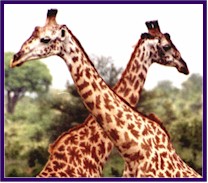
Giraffes
We saw a
Black-breasted Snake Eagle, a very cute Thomson's gazelle fawn, and a
Bunny Rabbit! We then had a really nice view of a group of ostriches.
They are much larger than you would expect!
The males are black with white on their wings, and the females
are brown. Blassy told us
the males share in the duty of setting on the eggs!
We had seen an ostrich egg by one of the cabins at the lodge, it
was huge, and the shell is extremely thick and hard.
Out on the plain, one
of the things that was quite interesting was to try to identify
different animals from a long distance by their shape and color.
The ostriches would appear on the horizon as small round black
dots, hovering slightly above the ground.
The zebras would appear gray from a distance, sometimes light and
sometimes dark, depending on which way the light was hitting their
stripes, their shape looked like an ‘m’ against the sky.
Wildebeests would have the shape of tiny boomerangs.
Lions would be seen as a small flash of tawny yellow.
The numerous gazelles would take on many colors and shapes,
depending on which way they were standing and on the light, we were
constantly mistaking them for other less common animals.
We had breakfast by a
huge Acacia tree that stood alone on the open plain.
We particularly enjoyed the hard-boiled eggs.
We watched Dung Beetles rolling their balls of dung around on the
ground. Apparently they lay
their eggs in some dung, roll it up into a ball, and pull it along
backwards until they happen onto a hole in the ground.
Then they bury the dungball, and just leave it there for the eggs
to hatch. We later saw a
cheetah, well camouflaged against the dry plain.
We made a few more
limericks.
The
Zebras have something to say
About being just anyone's prey.
They gaze while they snack
Over each other's backs,
So the lion will not have his way.
"It's
a mighty hard life", says the Bustard
"The guide says I go well with mustard.
I work hard to make
All the flesh that they take,
Can't you please just stick to custard?"
The
Lion's the King of the Beasts.
Nothing bothers him in the least.
He'll lie in the sun
And then have his fun
On the animal kingdom he'll feast.
Giraffe
sex is very fulfilling.
In preparation there is much milling.
But it's such a shame
To play the game
When you find that your mate is unwilling.
We went and visited a Masai village.
The Masai people lead a primitive lifestyle.
The village is enclosed in a fence of thorny bushes to keep the
lions out. The houses are
made of mud, sticks and cow dung, and are very small.
They have a small enclosure for the goats with high thorn fences,
and the cattle are brought into the circle of the village at night. In the daytime, they are taken out to graze, with young men
to guard them. Blassy told
us about the ritual of Masai boys becoming warriors, they must go out
and kill a lion. They go as
a group, the first one to strike the lion with his spear, if he
survives, becomes the head of the generation, and gets his pick of the
girls in the village for his wife.
Many young men are killed by the lions during this ritual.
The Masai women and children sang and did a jumping dance, and
Mom danced with them. The
village was fairly filthy and somewhat depressing.
A cute baby goat came out of one of the huts, someone handed it
to Patty, and it was filthy and covered with fleas!
There was an extremely cute baby donkey tethered outside.
It was interesting to see the Masai village, but the flies on the
babies' faces were more than Mom and Patty could cope with!
We went and visited
the Olduvai Gorge. We saw
the museum and the excavation sites.
This is where the Leakey family has discovered some of the famous
early man fossils. Liza found this particularly interesting, as she is an
Archeologist.
Then we went to see the Shifting Sands.
This is a crescent shaped pile of sand, about 35 feet high, made
from volcanic ash. The wind blows sand up the side of the pile and off the other
side, and so it shifts at an average of 17 meters per year.
As we approached it, we saw this big black shape of sand, with
markers leading up to it for about a half a mile, showing where it had
been in past years. It was
an extremely unusual formation, like a big black sand dune rising up out
of the grass, but no other sand anywhere around it.
We had a boxed lunch
in a grove of Acacia trees. We
saw a lizard on a tree. We
told Mary to come around the tree and look at it, but every time she
moved around the tree, the lizard would move around to keep the tree
between her and itself, she thought we were teasing her!
Blassy had indicated he is extremely scared of snakes, he said if
he saw one, he would not tell us, he would just keep on driving, so he
wouldn't have to stop and look at it.
We made a deal with Freddie, if he saw a snake, he should call
Blassy on the radio and tell him it was a leopard, so he would take us
to see it!
On the way home, in
addition to some nice giraffes and the other regulars, we saw an Augur
Buzzard, a Sand Grouse, and a small Steinbok.
Buzzards are fairly attractive birds in Africa, not anything like
vultures. We saw hyenas,
vultures and jackals together at a carcass.
To my delight, we saw some adorable baby zebras, and two zebras
scratching each other on the necks.
We saw two more leopard turtles, we stopped so Rob could rescue
one of them by moving it out of the road.
The last evening at
Ndutu, we sat out around the campfire.
The manager, Louise (who is an English Eventer), told us stories
about animals coming into camp. One
time two lionesses killed a hyena right in front of the cabins.
Once a hyena pulled the sink right off of the wall in one of the
worker's cabins. Five genet
cats came to dinner that night.
January
10: Day 4
We said goodbye to
Ndutu Lodge after a delicious breakfast.
We started out across the great open plain.
It had rained in the night, and everything was already starting
to look greener. The smell
of the plain was moister, earthier.
We saw much larger herds of wildebeest than we had seen before,
they had come to the area because of the rain.
It was surprising to us during the whole trip how localized the
weather was. One area would
look quite green because it had received a lot more rain, and we would
go just a short distance and find areas of drought.
Each area seemed to be it's own little weather ecosystem, and it
was amazing how quickly the herds of grazing animals would migrate to
areas where there had been recent rain.
We saw two tiny dots on the horizon that we could barely identify
as ostriches, but the eagle-eyed Blassy noticed many smaller microscopic
dots between them, so we went closer for a look.
It was a pair of ostriches with 18 tiny baby chicks!
They were very shy, and ran away from us, I could not get their
picture.
We saw a Golden
Jackal, it looked quite a bit like a red fox.
It was looking away from us when I wanted to photograph it, so I
told Patty to give a jackal call. She
yelled "willa willa" in a high pitched tone, and he looked
right at the camera and smiled!
We jokingly told Blassy we would like to see a leopard in a tree.
Leopards are not terribly common, and usually difficult to find,
but we could hope!
One of the high points
of the day for me was watching a large herd of zebras.
We saw many throughout the day, and at one point spent quite a
lot of time watching them. There
were many adorable foals that were fairly young.
We watched them play, and we saw some zebras bite and kick at
each other. We often saw
them standing side by side, facing opposite directions, scratching each
other's withers, just as horses do.
They are incredibly cute, like fat roly-poly ponies.
They have a braying-like noise they make that I just love.
Blassy told us they each have unique stripe patterns, like
fingerprints. I took lots
of zebra pictures!
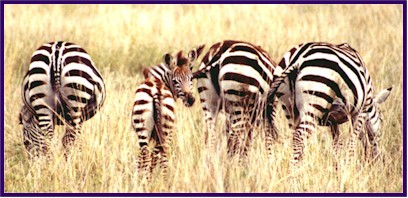
Zebras
(Click for larger view.)
We got our closest
view so far of some hartebeests, one of them made an incredible leap
over a ditch. We thought
they might go well cross-country, but the dressage could be a problem!
We went to Naabi Hill, a large Kopje that is the Park Gate to the
Serengeti, although it is well inside the park.
Kopjes are sudden rock outcroppings that rise up out of the
plain. They are actually
the tips of ancient mountains. The
area was filled with valleys and lakes at one time, and after volcanic
eruptions, the plain was formed from volcanic ash filling up the
valleys, leaving just the granite tips of some of the mountains sticking
up above the plain, like islands. We
hiked up the nature trail to the top of Naabi Hill, where we had an
absolutely incredible view of the plains in all directions.
We went through an
area where there were a number of kopjes.
We saw two Reedbucks up on one of them, and a number of Olive
Baboons. There was a Slender Mongoose, very quick and sleek.
Of course, we continued to see many of the usuals; especially
wildebeests, zebras, and gazelles in great numbers on the open plain,
and often warthogs, ostriches, topis and hartebeests, as well as eagles,
vultures, Kori bustards, guinea fowl and many of the smaller birds we
had become accustomed to. We
saw a hawk type bird called a Bateleur, and a Crowned Hornbill.
We saw a group of hyenas sleeping in a mud puddle, they lie in
the mud to cool themselves, looking especially revolting.
Whenever we went out
game driving, Blassy and Freddie would not necessarily stay right
together, although the two Rovers were usually in the same general area.
They could contact each other by radio, however, so if one saw
something interesting, the other would know about it.
That way we had better chances of seeing more game, without
having to wait for the other vehicle all the time, as we often had
different priorities.
We drove along a road
by a small tree-lined river, and we had a really exciting find, a
leopard sleeping in a tree! It
was high up, and extremely well hidden.
Freddie had spotted it and radioed to us, Blassy almost didn't
take us to see it, because he thought maybe it was really a snake, since
we had been teasing him about that!
You could barely see it from the road, (it was an amazing feat
for Freddie to have spotted it) but we were able to drive right up under
the tree for a closer look! The
leopard is an extremely beautiful animal, and also quite fierce.
Blassy told us that leopards would not hesitate to kill a person
on foot. He said they would
"make you meat". We
were quite excited to see the leopard, we had asked our guides to show
us one, and sure enough, they delivered!
So then I told Blassy I wanted to see a hippopotamus out of the
water.
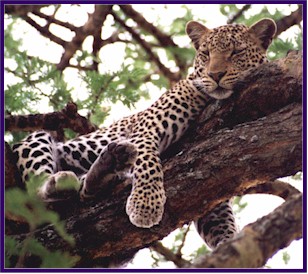
Sleeping leopard.
We stopped by the
Seronera Lodge to check out the gift shop, and saw some Hyraxes, small
rodent-like animals that are thought to be closely related to the
elephant, although we could not see the family resemblance!
They had become quite tame, you could get very close to them.
We passed some topis with small babies sleeping in the shade, we
got to see one of them get up and nurse.
He was very rough and rude!
We passed the hippo
pool, and saw an amazing sight, two hippos grazing, out of the water! It is quite unusual to see them out of the water during the
day, normally they only come out at night, and stay in the pools all day
to keep cool. We had
jokingly asked Blassy to show us this, but I didn't think it would
happen!
As we drove along a road near a river, we saw a White-headed
Buffalo Weaverbird, Black-faced Vervet Monkeys, a Bushbuck, Cape
Buffaloes and a glimpse of a Nile Crocodile in the water.
Five new species in five minutes!
We were driving along when suddenly Blassy slammed on the brakes
and came to a screeching halt, he had seen another leopard turtle, and
he stopped to put it out of the road.
Apparently Rob was rubbing off on him!
One of the things that made Blassy so appealing to us was the
attitude of intense appreciation and respect he exhibited toward the
animals at all times.
Whenever we came
across an interesting animal or sight, Blassy would stop, and generally
turn off the motor of the Landrover so it wouldn't scare the animals,
and so I could get pictures without the vibrations of the engine.
At one point in the afternoon we stopped to get some extremely
close up shots of an especially nice giraffe, and the Rover wouldn't
start up again. Blassy
tried and tried, to no avail. We
thought we might have to get out and push!
Blassy called Freddie on the radio, and he came to our rescue.
When he arrived, we were expecting him to stop and pull out
jumper cables or a tool kit, but he never paused, he just kept driving,
straight to us, and pushed us backwards so Blassy could pop the clutch
to start the engine, and away we went!
For the rest of the afternoon, Blassy only shut off the engine if
he was on a slope where he could get a rolling start.
He was able to get it repaired that evening.
More of our poetic endeavors:
Black
dots on the distant horizon
Turn out to be something surprisin'
Two ostrich with chicks,
Eighteen, just for kicks,
'Asante' to Blassy for realizing.
They gather around when
something has died.
Hyenas and jackals from far and wide.
Along with vultures
From many cultures
There's soon nothing left but bones and hide.
We arrived in the Seronera Campsite around 5:00 p.m.
It was absolutely fantastic.
There were four tents, (two people per tent), with comfortable
beds, chairs, a night table, and even a suitcase stand.
They had canvas floors, a portable toilet in a separate
compartment, and a shower rigged up that they would fill from a bucket
outside on a pulley. There were large windows all around the tents with
thick mosquito netting, and a front porch with table and chairs.
At night, they put kerosene lanterns out front for light, and
there were flashlights in the tents.
There was a dining tent with a table for ten, set with table
cloths, wine glasses, and fancy place settings with enough cutlery to
keep us confused as to which fork to use. The food was excellent, with an appetizer, soup, main course
and dessert at each meal. Wine
and beer were available. We
were pleasantly surprised during the whole trip with the quality of the
food, much better than we had expected.
The camp staff had
their tents down a little way from ours.
In addition to our guides, there were five other people to take
care of us. Solomon was our
cook, and our waiter was Blassy's cousin, Lupi.
There were people to bring us hot water for showers whenever we
wanted, and to clean our tents and do our laundry.
It was definitely luxurious, and we felt a bit guilty being
waited on so.
There were chairs around a campfire, and after dinner we sat
around the fire and talked. We could hear lions out on the plain, and Blassy told a
wonderful story about a close encounter with a leopard.
The weather in the Serengeti was absolutely lovely the whole
trip. One tends to think of
Africa being very hot, but due to the elevation, that was not the case.
In the daytime it was warm, but not uncomfortably so.
Occasionally a little hot in the sun, but very pleasant.
In the evenings, it was quite cool, we would wear long sleeved
shirts, and move closer to the campfire as it got later.
In the mornings, it was quite brisk, we would need jackets for
the early part of the game drives.
All in all, perfect weather.
Blassy and Freddie
warned us, no matter what we heard, no matter what happened, do not go
out of the tent in the night. They
also said if we heard animals close by, not to shine the flashlight, and
to stay quiet.
It was wonderful to
lie in the tent at night and listen to the animal noises.
I heard some small scuffling sounds just outside, and hyenas in
the distance. Patty was not
responsible for the sounds this time, she and Rob were lying in their
tent hearing the same things, while absolutely enjoying a state of mild
apprehension. I heard some
calls close to the tent that I was told later were probably jackals.
Once I heard hoofbeats, it sounded like several large hoofed
animals passing quickly close by, Blassy said the next morning it was
probably giraffes or zebras. (There is a saying, "If you hear
hoofbeats, look for horses, not zebras", but I guess that doesn't
apply in Africa!) Patty
thought she heard a noise once and looked out to see a zebra grazing
just outside her window, but then the next morning she wasn't sure if it
really happened or was a dream!
January
11: Day 5
We got up early and
left at 6:15 a.m., just as the sun was beginning to rise.
We set off across the plains, enjoying the quiet and the early
morning light. It was a
different feel from the early morning at Ndutu.
We saw three Elands. They
are the largest of the antelope, very cow-like, and quite shy.
We couldn't get too close to them.
They were very pretty movers!
There were small white flowers scattered in the grass, similar to
small morning glories, Blassy called them 'waste paper flowers', as they
resemble bits of litter dropped on the ground here and there.
We saw two male lions resting, not too far from the camp.
They were sleeping and loafing, right out in the open.
We saw Black-backed Jackals, also known as Silver-backed Jackals,
several times. They have a
silvery black colored back, so we renamed them the Silvery Black Backed
Jackal, or the SBBJ, for short, much to Blassy's dismay.
Then we got some action! We
came upon a huge herd of hundreds of wildebeests, the largest we had
seen. They were traveling
along in a tightly grouped string.
We saw a hyena following, and then chasing them.
The wildebeests started running, and the hyena was gaining, and
was joined by several of his friends.
Soon there were about a dozen hyenas attacking, and the herd was
genuinely on the run. They went in big circles, with the hyenas attempting to
separate them, then the hyenas chased them a fair distance. Ultimately, the wildebeests all escaped, but Blassy said the
hyenas must not have been too hungry, as they surely could have made a
kill if they had been really determined.
Wildebeests are very numerous, but not very smart.
They are comical looking, Blassy said they are called the
'spare-parts animal', and that is what they look like.
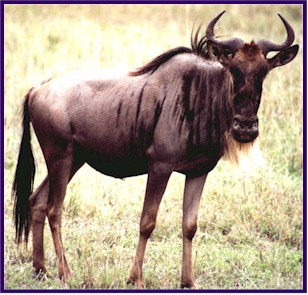
A wildebeest.
Further along the
road, we saw another group of hyenas who were coming from a kill.
They had extremely full bellies, and several were carrying spare
wildebeest bits to snack on later.
I told Blassy it was time for some cheetahs.
We then had the high
point of the day. We came
across seven cheetahs; a mother and her six almost grown babies.
They were absolutely beautiful.
Blassy spotted them at a distance, and we set off across the
plain. They were walking
along, unbothered by our vehicle. We
watched them as they stood on top of a termite hill, and as they
traveled across the plain. The cheetahs are the fastest of all land
mammals. They are sleek and
long-legged, and built for speed. They
have keen eyes, and hunt by sight.
Blassy told us that this must be an exceptionally good mother,
that normally they only have two to four babies, and to raise six to
adulthood was incredible! We
could identify which were the babies by the coarse longer hair on the
back of their necks.
Soon afterwards, we
were driving along by a small river, and Blassy said he smelled lions. Sure enough, we soon came upon a pride of 16 lions.
They had recently killed a wildebeest, right beside the stream.
Several of the half-grown cubs were eating, rather grossly.
They chewed and pulled and gobbled, often burying their entire
heads inside the abdominal cavity of the carcass.
There was an adult male sleeping on the road, and several
females, all of whom had already eaten and were resting.
There were about a dozen partly grown cubs, from several
different litters. We
watched them play and wrestle and roll down the slope.
Many of the lions had streaks of blood and gore on their faces,
but seemed unconcerned about cleanliness.
There was a whole group of Vandebeests watching; that is what
Blassy calls the white tourist vans.
When we continued on, we noted a Black-headed Heron, a
Black-bellied Bustard, and a group of Marabou Storks.
We passed a lovely lake, and then saw a fairly large group of
elephants from a distance. Unfortunately,
they were not close enough to the road to see really well.
We went into a spectacularly beautiful area with many huge
kopjes. The scenery was
breathtaking. We stopped at
a place called Gong Rocks. It
was a large kopje with a huge slab of stone at an angle, with several
enormous granite-like boulders sitting on it.
There were large Candelabra trees growing there.
We climbed up the slippery rock, and saw rows of fist-size
indentations in the boulders, Masai people hundreds of years ago had
formed these by hitting the boulders repeatedly with a stone.
It would ring out with a sort of hollow metallic sound, each
indentation would make a slightly different tone.
This place was used for tribal ceremony and music.
We were surprised to find elephant dung at the top of the steep
slope, Blassy said elephants are actually quite good climbers!
We also saw some very colorful Agama Lizards on the rocks, the
males are pink and purple. We
visited another interesting kopje, where there were Masai paintings on
the wall of a shallow cave, dating back to the middle of the nineteenth
century. There was some
discussion about the meaning of the symbols, and the possibility that
some of them are more recent than others, one drawing looked
suspiciously like a person on a skateboard.
We then started
heading back to the camp, since we were already late for our 11:30
brunch. We told Blassy that the morning had been great, but to make
it really perfect, we'd like to see the elephants we saw in the distance
earlier close up, it would be nice if he arranged for them to be closer
to the road.
Sure enough, when we returned to the area where the Elephants had
been, they were moving towards the road.
We stopped, and a group of eleven crossed the road right next to
us! If we had been
five minutes earlier or later we would have missed them.
There were several babies of various sizes, and one very small
one. We couldn't get a very
good look at the little one, because all of the others crowded around
the baby and shielded him from our view as they went by.
It was a great chance to see elephants close up, and we marveled
at how anything we told Blassy that we wanted to see seemed to
miraculously appear!
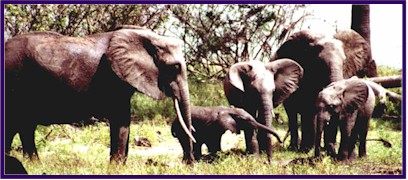
A group of elephants.
On the way back to
camp, we saw one more thing that we had mentioned we would like to see,
a lion in a tree! We passed
a lioness sleeping up on the branch of a tree.
Lions are not nearly as good climbers as leopards, so they prefer
a tree that leans a little so it is easier to get into.
After a fabulous morning, we returned to the camp for a delicious
brunch around 12:30. We
immortalized the morning.
The
Wildebeest cover the plains.
They migrate to follow the rains.
Also known as the gnu,
It's sad but it's true,
They were last when God handed out brains.
This morning was game viewing heaven.
Lions feeding, and cheetahs by seven.
A lion in a tree,
The wildebeests flee,
And elephants numbered at eleven.
We went back out at 4:00 for the afternoon drive.
It was fairly hot, and things were pretty quiet to begin with.
We told Blassy we would like to see another leopard, this time
out of a tree.
We saw many
interesting birds, among them several new to us, a Harrier Hawk (also
known as a Gyimnogin) and a Magpie Shrike.
We found the birds of Africa quite interesting, and often spent
quite a bit of time looking at them.
Rob expressed in interest in becoming adept at Vulture
Identification, so Blassy conducted Vulture Lessons.
We went back to the
area where we had seen the leopard the day before in hopes of finding
him again, and he was sleeping in a tree nearby, with his legs and tail
dangling down. We were not
very close to him, there were several other vehicles around watching
him, and it was quite hot since we were sitting still, but Blassy felt
that it was worth waiting to see if he would come down.
And boy did he prove to be right!
We waited until nearly sunset, as that is when there is likely to
be some activity, and most of the other viewers left.
Finally, the Leopard started to move, he yawned and stretched
quite a few times, then he finally got up and leaped down out of the
tree. He followed the creek
bed a short distance, and then he walked over to the road and right past
us! It was as if he was
showing off and giving us a good look at him on purpose.
He was absolutely beautiful!
Blassy told us later that it was the best viewing of a leopard he
had ever had.
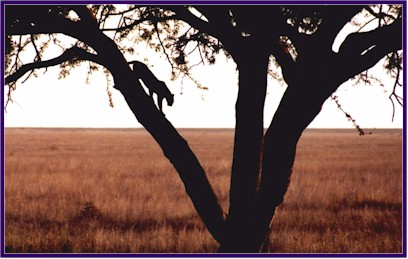
Leopard coming out of his tree.
On the way back to the camp, we again saw two hippos grazing out
of the water, and a whole flock of Marabou storks in the trees.
We got into camp just after dark.
What a great day!
We had asked Blassy for clear skies for star viewing, and animal
noises at night. It was a clear night, and as we sat around the campfire the
stars were absolutely incredible. They
were so bright, and so many, that we had a hard time even picking out
Orion against the diamond-studded background!
All of the familiar constellations were in different locations,
and seemed upside down. One
whole side of the sky was filled with stars and constellations that we
hadn't seen before, stars of the Southern Hemisphere.
I don't know if I have ever seen the stars so bright!
We still were not able to see the Southern Cross, as it was
apparently only visible in the early morning at that time of year.
We sat and talked at the campfire, and Rob sang the song about
what was under the Scotsman's kilt.
After the others went to bed, Patty and I stayed up and talked to
Blassy for another hour or so. We heard lions roaring and calling several times, as well as
hyenas and other night noises. The
sound of the lions roaring, way out in the darkness, is one of the
things I will always remember about Africa.
Patty and I stood
awhile longer outside the tents and talked after Blassy went to bed.
We heard the lions again, closer this time, and then heard
movement in the brush close by. We
decided we had better get inside! Shortly
after going to bed, I heard a snarl and a growl, followed by hyenas
calling, right outside our tent! I
tried to look out the windows and see them, but it was too dark, which
was probably just as well; I realized when I looked out that there was
nothing between them and me except mosquito netting!
We heard crashing and banging from the lower end of camp, we
learned in the morning that several hyenas came into the camp and
ransacked the kitchen tent! One
carried off a water bucket, and bit a big chunk out of it, ruining it.
Sweet dreams!
January
12: Day 6
I woke up early in the morning, as I did during my whole stay in
the Serengeti, excited and ready to go.
I wanted to go out and look at the stars, and maybe see the
Southern Cross, but of course I didn't dare leave the tent while it was
dark, especially after hearing the hyenas last night!
We left at 6:00 a.m.,
and it was a beautiful sunrise. Unfortunately
there were too many clouds to see the Southern Cross in the morning, but
Venus was high in the sky and incredibly bright.
One of the first things we saw was a lioness, Mom spotted it next
to the road in the dim light. We
watched a troop of baboons go about their business, the most amusing was
a small baby riding on his mother's back.
We followed a road along the Seronera River.
We saw hippos in the water, and we saw many more Impalas among
the trees than can be found on the open plain.
We passed a huge herd of hundreds of Cape buffaloes.
They are very impressive, with their huge cumbersome horns.
We saw one bull trying to mate, but unfortunately the one he
mounted was also a bull, so it didn't work too well.
We also passed two elephants that we almost missed, amazingly
well concealed in the underbrush. One
of them was a 'five-legged' elephant, Blassy said he must be thinking
about his girlfriend!
We saw an incredible number of birds along the river drive.
Some of the ones that we had not seen before included two
beautiful Hooded Kingfishers, a flock of Night Herons in the trees, the
Little Bee-eater, some Yellow-throated Longclaws, and the White-browed
Coucal. We saw some lovely
Silverbirds, a silvery gray with orange breasts, a Cardinal Woodpecker
and the small turquoise colored Cordon-blue birds.
There were White-crowned Shrikes, Gray-backed Fiscals, a
Gray-headed Kingfisher and a Gray Hornbill.
One of my favorites was the Red-billed Hornbill, I love its
up-and-down swoops and dips when it flies.
We saw the very large Yellow-billed Stork, and a pair of Egyptian
geese sitting up in a tree. We passed a whole flock of Fischer's lovebirds, with their
brilliant neon colors, there were about 16 of them. In the wild they are somehow much more brilliant than when
you see them in captivity.
We also saw many of what Blassy called LBBs.
This stands for Little Brown Birds.
I suppose if we were really serious birdwatchers we would have
been more interested in identifying these, but as much as we enjoyed the
birds, we decided that LBBs didn't really count, we liked the ones that
were pretty, interesting or unusual.
We passed a giraffe
right by the side of the road, very close up.
I never get tired of seeing them, they are so elegant and
beautiful, I especially love their faces, they have kind gentle
expressions and incredible eyelashes.
We again passed a large hippo out of the water.
Patty gave her hippo call (willa willa) to get him to pose for a
picture. This worked well on many different types of animals, but was
not too effective on impalas or gazelles, it makes them leave!
We told Blassy we
wanted to see some baby warthogs, close up.
We arrived at the
Retima Hippo-pool, a fairly large pool at the juncture of the Orangi
River and the Seronera River. We
were able to get out of the rover and have breakfast there.
There were a great number of hippos in the pool, and also quite a
few crocodiles, lying on the banks.
They were a sort of yellowish gray color, and quite evil looking.
One large one leaped into the water amazingly fast with a big splash
when we approached. We also saw some giraffes and a Cape buffalo that had come
down to the water to drink.
We enjoyed watching the hippos.
They mostly hang out in the water, every so often one would rear
up out of the water and splash around, or a baby would get up on its
mother's back. They make a
wonderful humorous sounding noise when they call out. The hippo pool was nasty.
It was fairly stagnant, with lots of hippo poop floating around
in it; it looked like a very unpleasant place.
Patty looked at the scummy pond and said her doctor had advised
her it would be unhealthy to swim in the water while on this trip, I
said, "Yes, because you might get Hippotitis!"
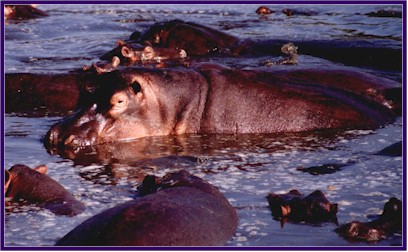
Hippos
As we left the pool,
we saw a mother warthog with four babies.
They are really ugly, but very cute, especially when they run
with their tails straight up over their backs.
Blassy had delivered another of our requests.
We told him that we wouldn't mind seeing some more elephants,
perhaps playing in the water. Also,
since he had shown us everything we had asked for so well, we would make
it harder for him, perhaps an elephant in a tree!
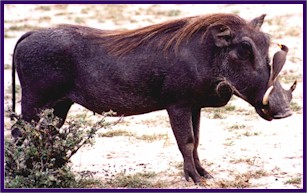
Warthog
We continued to see
giraffes everywhere. We
passed near a small mountain, and from a distance we could see giraffes
up on the side of the ridge, eating in the trees.
We came across a group of elephants.
There were three mothers, two babies and several medium sized
adolescents. They were
quite close to us, and absolutely marvelous! They were just coming out of the river when we arrived.
They ate, the babies played, and we got to watch them interact.
We saw one of the babies nurse, the mother elephant's bag is
between her front legs. Two babies fought over who got to roll in the
mudpuddle, the smallest one jumped on top of the other baby, then rolled
off and hit the ground with a sudden squeal of surprise.
The mothers all hurried over, examined the babies with their
trunks to be sure no one was hurt, and broke up the little fight.
Patty said it reminded her of Mom saying “You all stop that
romping before someone gets hurt,” to us when we were kids.
We noticed several elephants scratching themselves on the trunk
of a tree. One of them
stepped over a low limb and got a little stuck there straddling the
branch, I said, "Blassy, there is our elephant in a tree!"
They all moved towards
us. Mom took this
opportunity to lecture them on conservation of resources, but they were
unimpressed. The group passed within a few feet of us, almost close enough
to reach out and touch. They
crossed the road immediately in front of the Rover, one of the mothers
reached out and touched the hood with her trunk!
It seemed a magical moment.
She stood in the road like a ‘crossing guard’ at an
intersection while the others filed across the road one by one.
One of the babies hesititated and its mother pushed it from
behind. The smallest baby
went much farther away from the Landrover than all the others, looked
apprehensively in our direction, then ran across as quickly as it could.
I said, "Blassy, the next time could you get us a little
closer?" It was the
best imaginable elephant viewing, definitely one of the most memorable
moments of the trip. The
elephants are so intelligent, and their interactive behavior is
fascinating to watch, Patty says they are her favorite African animal.
It was amazing that Blassy seemed to deliver everything we
mentioned that we wanted to see!
On the way back to camp, we saw a lioness hunting.
We watched her from a distance as she was trying to sneak up on
some topis. A couple of
reedbucks saw her and cried out in alarm, warning the topis, so the
lioness had to give up. The
warning call of the reedbucks is a repeated shrill ‘whee’, almost
like the scream of a child, that doesn’t seem like it would be coming
from an antelope.
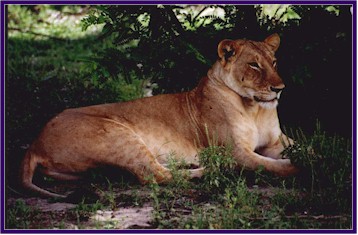
Lioness
We returned to camp
for lunch. What a fabulous
morning!
We went back out in the afternoon at 4:00.
I had just finished reminding Rob that I had asked Blassy for
lions up on a kopje, when we came across a lioness, high up on a rock
outcropping, just as I had requested!
We watched, and saw cubs up there with her.
More and more started to appear, eventually we counted three
lionesses and ten cubs, quite young.
We watched the cubs play for about an hour and a half.
They were adorable! They
played in a bushy tree growing on the kopje, then they climbed up to the
top of it to drink from a rainwater pool.
When they came down they romped some more.
One of the lionesses was wearing a radio collar, it was put on
with the aid of tranquilizer darts by people who are conducting studies
of the wildlife in the Serengeti.
We also saw some more
bat-eared foxes, Patty did her bat-eared fox call (willa willa), it
worked like a charm. We
also saw a Lesser Grey Mongoose, a Fischer's Sparrowlark, a Red-billed
Oxpecker and some Hildebrandt's Starlings.
We were not having any trouble identifying at least one new
species we had not seen before on every game drive!
One depressing thing happened.
We were driving along when Blassy came to a sudden halt, and
there was a wire snare in the road. He said some animal had probably been caught in it outside
the park, and dragged it into the Serengeti before managing to become
free of it. Snares are very
cruel, usually leading to much suffering and a painful death for the
animal that gets caught in one. Blassy
said that he did not dare bring the snare with us, because he could not
risk someone finding it in his Landrover, but he untied the loop,
rendering it harmless. He
told us that being a Park Ranger is a very dangerous job, and that
poachers kill many Rangers.
We returned to camp just before dark. We met Peter, an Englishman
who is the owner of the Hoopoe Safari Company. He and his son joined us
for dinner, and stayed in camp overnight.
It was Greg's birthday, and the cook, Solomon, had baked him a
delicious birthday cake. All of the excellent food in the camp was cooked right there
in Dutch ovens or over the fire. Even
the bread was baked there, and had a delicious smoky flavor.
We sat around the fire again after an excellent dinner, and
talked about the day's sightings. The
elephant encounter was really special.
Blassy told us that this trip, our Safari, seemed to be
especially blessed. Many of
the opportunities we had to get close to some of the animals were
uncommon. We all felt it
was uncanny and amazing how whatever we mentioned seemed to come true!
So we said we wanted
to have lions close to the camp in the night, we enjoyed hearing them
nearby!
Continue... |